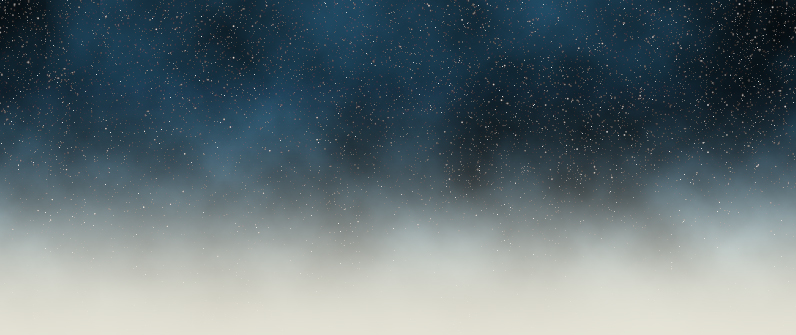Historical Overview of X-Wind Modeling

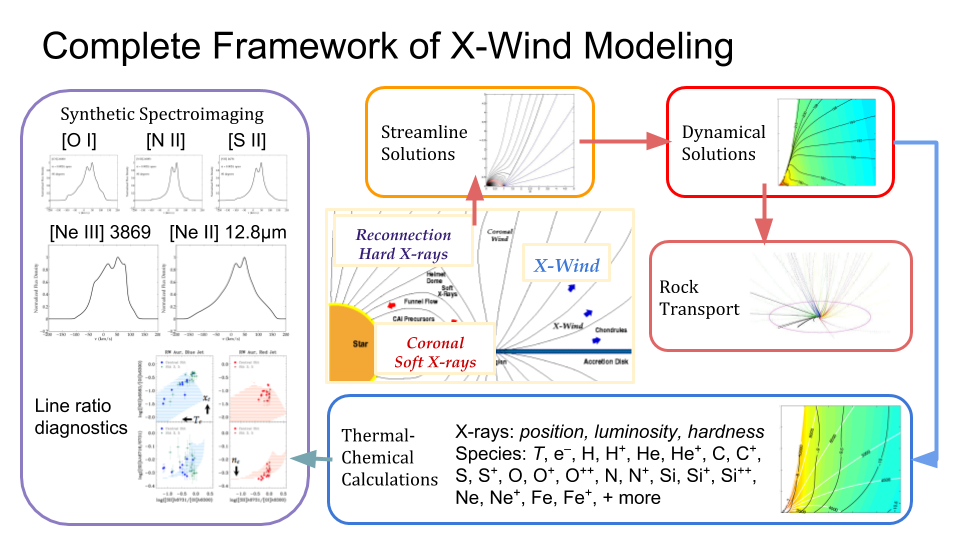
Dynamics of the X-Winds
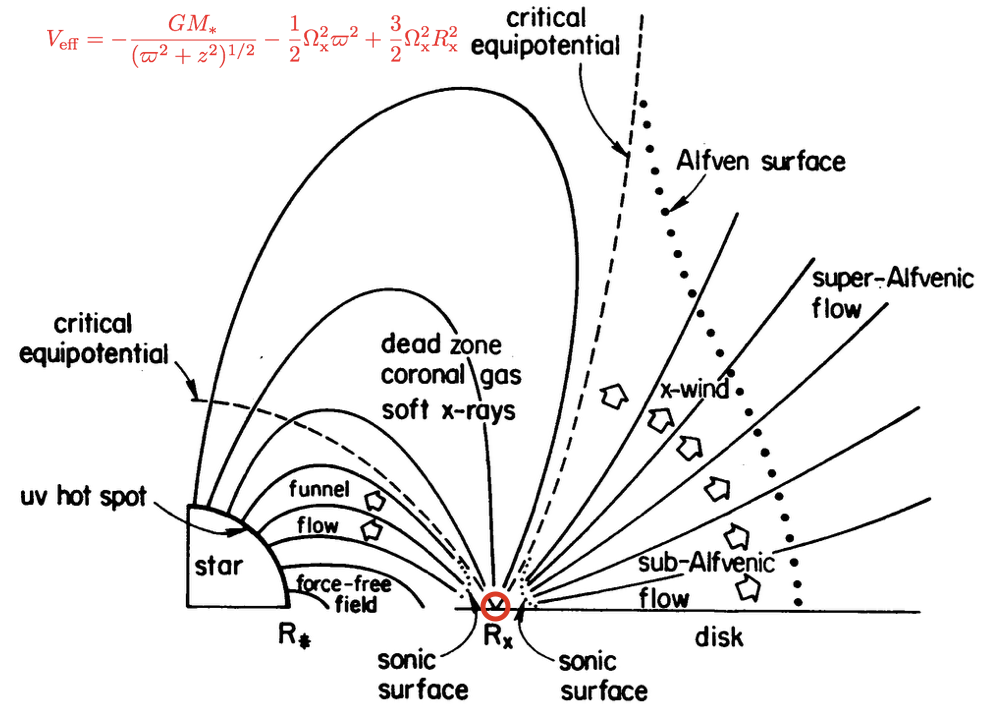
Heating–Cooling and Chemistry in the X-Winds
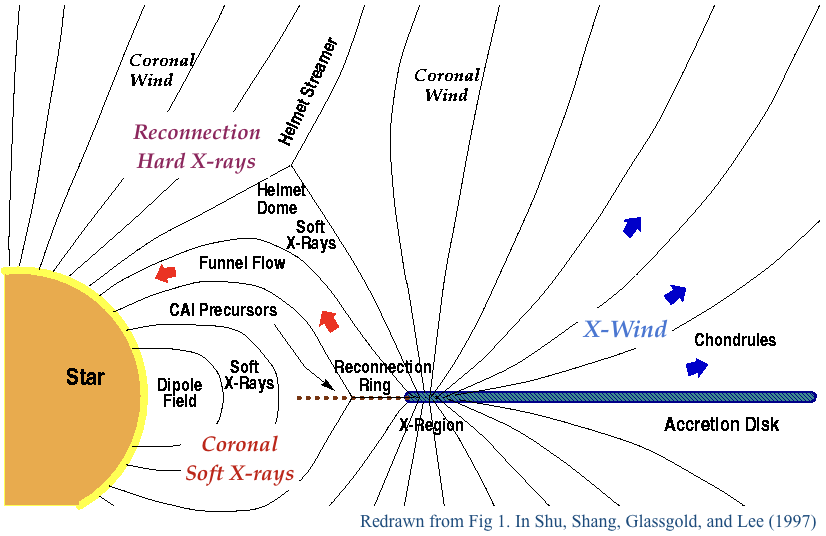
Schematic drawing of the magnetic field geometry and gas flow in the x-wind model for the production of CAIs and chondrules
While chondrules are being launched from the x-region, cosmic-ray irradiation of CAI precursors occurs by impulsive flares in the reconnection ring, where the distorted dipole field lines make an excursion to the x-region as a part of the magnetic flux trapped there. The figure indicates that thermally driven coronal winds from the star and the disk may help the magnetocentrifugally driven x-wind to open field lines surrounding the helmet streamer, but this aspect of the configuration is not essential to our model.
The code is developed in order to provide self-consistent predictions of emission-line properties based on the low-mass protostellar jet and wind structure described by the X-wind model (Shu et al. 1994, 1995). The dynamical solutions of the X-wind model (Shang 1998) are first used as input to calculate temperature and ionization properties using balance in energy (cooling/heating) and mass (ion production/destruction) laid out in Shang et al. (1998, 2002). X-rays from close to the star provide the dominant ionization source and the consequent chemical processes, and mechanical heating from kinetic energy dissipation in the jet provides important sources of heating.
Detail balance of level populations of various ionization status of abundant elements is then solved using the calculated temperature and electron density under the optically thin limit that is justified in the more revealed stage of T Tauri Stars. Several three-dimensional (x,y,z) data cubes are obtained, containing volume emissivities of the lines and velocity components in the x, y, z directions. Synthetic position–velocity diagrams and channel maps can be extracted from the data cubes, with user-specified sampling rates and resolutions in both the spatial and spectral dimensions.
Currently, the code has utilized the axisymmetric X-wind solutions to interpret the general properties of jets from T Tauri Stars. The figures below shows the comparisons between synthetic and observed spectra, using the example of RW Aur A. The figure below shows the procedure of the comparison. The lowermost figures show the model solutions for RW Aur A: the left shows the density (color scales) and velocity (black contours) of the best-match dynamic model, and the right shows the subsequent temperature (color scales) and electron fraction (black contours) from thermal–chemical calculations the obtain the best-matched results with the observed line properties.

X-wind solutions based on observed constraints of RW Aur
Left: electron number density in color and poloidal velocity in black contours. Right: temperature in color and electron fraction in black contours. In each panel, the left and right figures are fitting to the blue- and red-shifted lobes, respectively. The X-wind solutions for the two lobes have different mass loading and these physical properties are self-consistently solved by matching the velocity and brightness asymmetries observed in the jets.
Synthetic Spectroimaging of the X-Winds
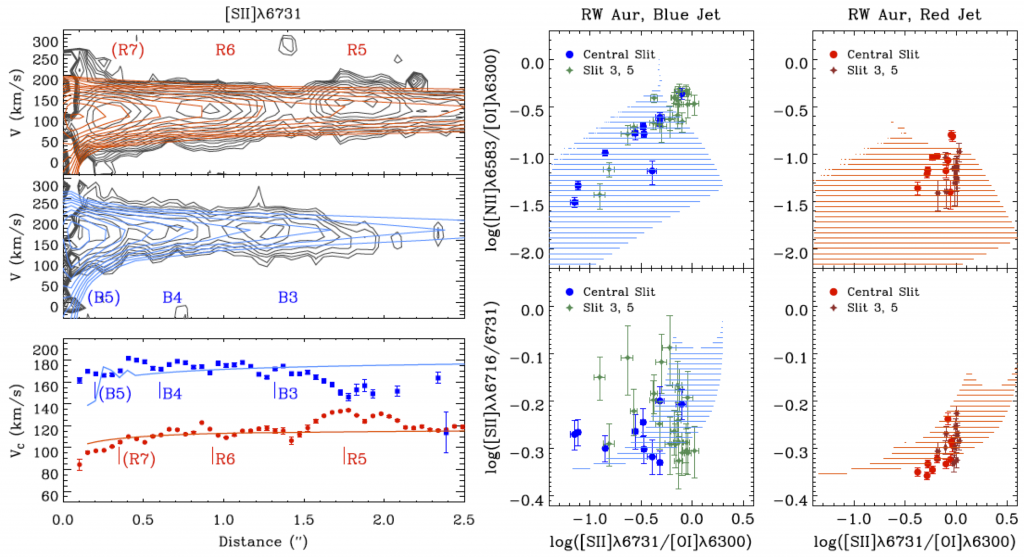
Comparisons between HST/STIS observed spectra and X-wind synthetic spectra
Left: optical [S II] line position–velocity diagrams of the blueshifted and redshifted microjets from observed (black contours) and synthetic (red and blue contours) spectra, and their velocity centroids (observed values in discrete symbols and modeled values in solid lines). The X-wind model solutions are obtained individually from the two sides of the jet constrained by their radial velocities and line intensities.
Right: optical line-ratio diagnostic plots from [O I], [N II], and [S II] lines. The observed values are in discrete symbols and the synthetic values are in color shades. The loci from the blueshifted and redshifted microjets do not overlap on the plots, suggestive of different physical conditions in the jet.
Science Results
The microjet from RW Aur A has a textbook appearance of collimation and one-velocity component, yet its asymmetric kinematic and morphological properties between the blueshifted and redshifted sides has puzzled researchers for decades. Using dynamic solutions and self-consistent thermal–chemical calculations based on the X-wind models, we interpret the underlying physical conditions in the microjet and account for its apparent asymmetries based on the archival HST/STIS spectra reported in Woitas et al. (2002).
Large-scale morphology and time evolution are investigated for the unified model of bipolar outflows outlined in Shang et al. (2006), where an outflow forms by a radially directed, wide-angle magnetized wind interacting with magnetized isothermal toroids in various quasistatic states. The primary wide-angle wind is toroidally magnetized and maintains a cylindrically stratified density profile, mimicking the asymptotic solution of the cold X-wind model. We explore the interplay between the toroidally magnetized primary wind and the surrounding toroids threaded by poloidal magnetic fields and examine how the jet and shell morphology and fine structures within them vary with the physical parameters. The variation in flatness of the density distribution in the ambient isothermal toroids helps shape the varieties of lobe morphology and collimation. The presence of a stronger ambient poloidal field helps shape the outflow, forming a magnetic cocoon and nested multilayered cavities surrounding the wind-filled lobe, which is most evident in the more open configurations of the ambient toroids. The wind–toroid interface is prone to substantial shear and thus unstable to the Kelvin-Helmholtz instability. Magnetic forces in the compressed toroidally magnetized high-velocity wind can generate vorticity, leading to nonlinear patterns within the extended magnetized mixing layers. Magnetic disturbances generated by the interplay could modulate lobe shapes, density, and velocities, giving rise to visual impressions of thicker and rugged shells and apparent episodic distribution of matter. The system maintains a quasi-self-similar evolution in time, which serves as a proxy for understanding the underlying physical mechanisms driving it.
Related Publications
- Liu C-F; Shang H; Herczeg GJ; Walter FM, “Revealing Ionization Conditions of Sz 102 with Spatially Resolved [Ne III] Microjets”, ApJ: 909(2), id.196 (12pp.), Mar, 2021 [SCI] ( ADS | Fulltext )
- Shang H; Krasnopolsky R; Liu C-F; Wang L-Y, “A Unified Model for Bipolar Outflows from Young Stars: the Interplay of Magnetized Wide-Angle Winds and Singular Isothermal Toroids”, ApJ: 905(2), id.116 (52pp.), Dec, 2020 [SCI] ( ADS | Fulltext )
- Liu C-F; Shang H, “RW Aur A from the X-Wind Point of View: General Features”, ApJ: 761(2), 94, Dec 20, 2012 [SCI] (ADS | Fulltext )
- Shang H; Glassgold AE; Lin W-C; Liu C-F, “Ne II Fine-structure Line Emission from the Outflows of Young Stellar Objects”, ApJ: 714(2), 1733-1739, May 10, 2010 [SCI] ( ADS | Fulltext )
- Shang H, “Jets and molecular outflows from Herbig-Haro objects”, Ap&SS: 311(1-3), 25-34, Oct, 2007 [SCI] ( ADS | Fulltext )
- Shang H; Li Z-Y; Hirano N, “Jets and Bipolar Outflows from Young Stars: Theory and Observational Tests”, Protostars and Planets: V, 261-276, 2007 ( ADS | Fulltext )
- Shang H; Allen A; Li Z-Y; Liu C-F; Chou M-Y; Anderson J, “A Unified Model for Bipolar Outflows from Young Stars”, ApJ: 649(2), 845-855, Oct 1, 2006 [SCI] ( ADS | Fulltext )
- Shang H; Lizano S; Glassgold AE; Shu FH, “Free-free Radio Emission from Young Stellar Objects”, ApJ: 612(1), L69-L72, Sep 1, 2004 [SCI] ( ADS | Fulltext )
- Shang H; Glassgold AE; Shu FH; Lizano S, “Heating and Ionization of X-Winds”, ApJ: 564(2), 853-876, Jan 10, 2002 [SCI] ( ADS | Fulltext )
- Shang H; Shu FH; Glassgold AE, “Synthetic Images and Long-Slit Spectra of Protostellar Jets”, ApJ: 493(2), L91-L94, Feb 1, 1998 [SCI] ( ADS | Fulltext )
- Shu FH; Shang H; Glassgold AE; Lee T, “X-rays and fluctuating x-winds from protostars”, Science: 277(5331), 1475-1479, Sep 5, 1997 [SCI] ( ADS | Fulltext )
- Shu FH; Shang H; Lee T, “Toward an Astrophysical Theory of Chondrites”, Science: 271(5255), 1545-1552, Mar 15, 1996 [SCI]( ADS | Fulltext )
